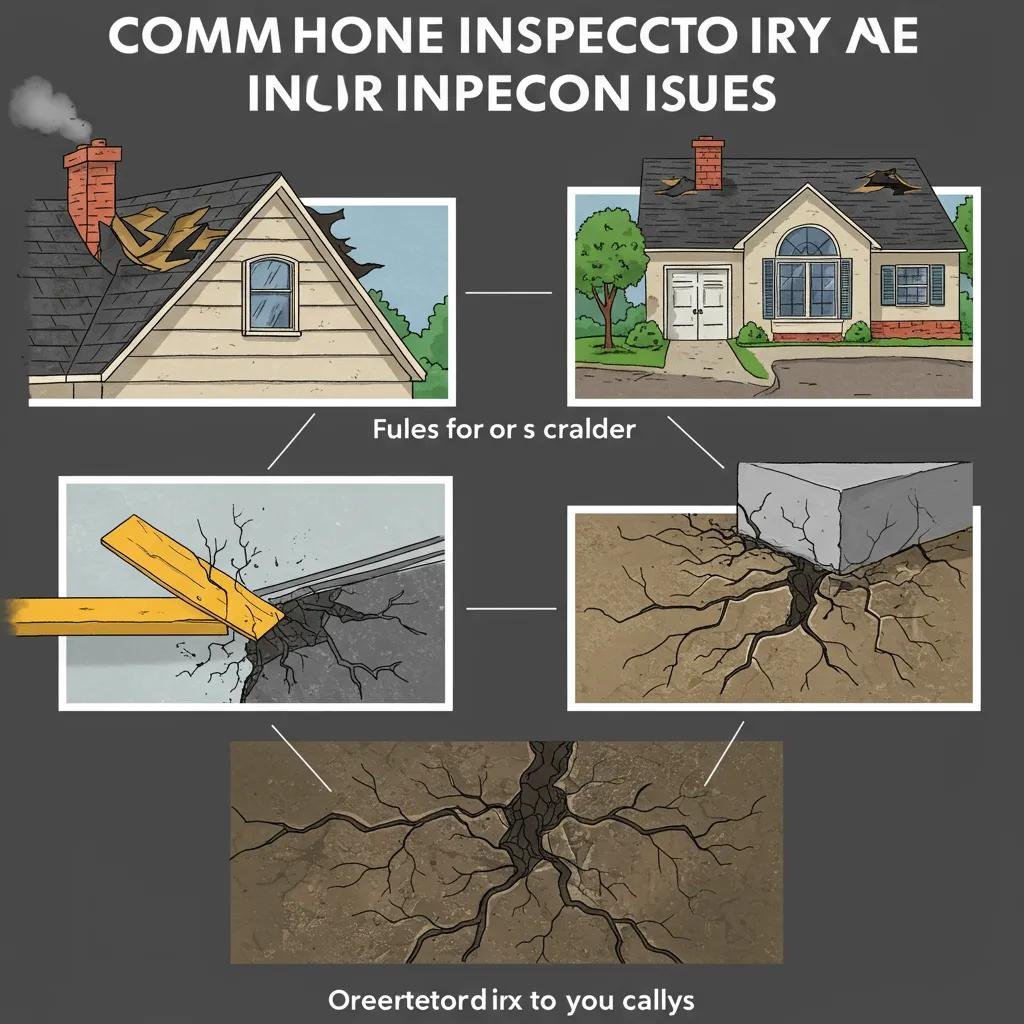
Property Inspection Checklist for Home Sellers Explained: What to Expect and How to Prepare
A surprising 30% of home sales encounter costly delays due to inspection findings, leaving sellers scrambling for repairs or renegotiations. This guide delivers a clear property inspection checklist for home sellers, outlining what inspectors examine, common red flags, and whether you should address issues before listing. You’ll learn to navigate structural, electrical, plumbing, HVAC, and optional areas, weigh repair versus selling as-is, and discover how Sell My House Pro’s cash-buying solution can eliminate inspection hassles. Read on to master the inspection process, identify top ten red flags with repair-cost insights, compare pros and cons of repairs versus an as-is sale, and see step-by-step how to secure a fast cash offer.
Delays in Home Sales Due to Inspection Findings
A significant portion of home sales experience delays due to issues discovered during property inspections. These delays often lead to complications in the closing process, requiring sellers to address identified problems or renegotiate terms with buyers. This can result in financial strain and extended timelines for both parties involved in the transaction.
This research supports the article’s claim about the impact of inspection findings on home sales.
What Is a Property Inspection and Why Is It Important for Home Sellers?
A property inspection is a professional evaluation of a home’s condition that identifies defects, safety hazards, and maintenance issues to inform both seller disclosures and buyer negotiations. By revealing structural cracks, electrical faults, or plumbing leaks before listing, sellers can avoid last-minute surprises that derail deals or trigger price reductions. For example, spotting a roof leak early allows targeted maintenance rather than renegotiating thousands off the sale price. Understanding these inspection scopes sets the stage for a smoother closing—and highlights why some homeowners opt for an alternative cash sale to bypass repair obligations.
What Does a Home Inspection Cover for Sellers?
A seller-side inspection typically encompasses all critical systems and components to provide a full picture of property health. Key areas include:
- Roof and gutters: assessing shingle integrity, drainage, and potential water entry
- Foundation and walls: checking for cracks, settling, and moisture intrusion
- Electrical system: verifying wiring condition, panel capacity, and grounded outlets
- Plumbing system: inspecting water supply, drain lines, fixtures, and visible leaks
- HVAC units and appliances: evaluating performance, filters, ductwork, and safety controls
Who Performs a Property Inspection and What Are Their Roles?
A certified home inspector—often affiliated with organizations like ASHI or InterNACHI—conducts the primary evaluation, documenting findings in a detailed report. Specialized contractors (e.g., electricians, plumbers, HVAC technicians) may follow up on flagged items for deeper diagnostics or cost estimates. This collaborative approach ensures that each defect is accurately identified and quantified, empowering sellers to make informed decisions on repairs versus selling as-is.
How Long Does a Typical Home Inspection Take?
A standard home inspection spans two to three hours depending on property size, age, and complexity of systems. A 2,000-square-foot ranch with basic plumbing and electric may take around two hours, while a multi-story home with extensive mechanical equipment can extend to three hours. Completing this assessment early in the listing process allows sellers to address critical items or plan for alternative selling options without eating into marketing time.
What Are the Key Items on a Home Seller’s Inspection Checklist?

A thorough pre-listing checklist empowers sellers to review every vital component, reducing negotiation leverage for buyers and minimizing last-minute fixes. Below is a focused overview of the most critical inspection points:
| Component | Inspection Focus | Typical Findings |
|---|---|---|
| Roof & Gutters | Shingle wear, leaks, drainage | Missing shingles, clogged downspouts |
| Foundation & Walls | Cracks, settlement, moisture | Vertical cracks, efflorescence |
| Electrical System | Wiring safety, panel clearance | Ungrounded outlets, overloaded breakers |
| Plumbing System | Pipe integrity, fixture leaks | Corroded fittings, slow drains |
| HVAC & Appliances | Performance, age, safety controls | Dirty filters, thermostat issues |
Each inspection item on this checklist presents an opportunity to preempt costly negotiations or decide if a as-is cash sale makes more sense than investing time and money into repairs.
How to Inspect Structural Elements: Roof, Foundation, and Walls
Begin by examining the roof from ground level for missing or curled shingles and checking gutters for debris that could trap water. Walk perimeter walls inspecting for cracks wider than 1/8 inch or signs of moisture staining. Inside, look for uneven floors or sticky doors that may indicate settling. Addressing these structural elements early prevents major contingencies late in the sale process.
What to Check in Electrical and Plumbing Systems?
Test every outlet and light fixture to ensure proper grounding and function, then inspect the electrical panel for labeling accuracy and clearance space. Under sinks and around water heaters, look for rust, pooling water, or corrosion on pipe joints. A well-maintained electrical and plumbing system reduces safety concerns and maintains buyer confidence.
How to Review HVAC and Appliances Before Selling?
Run heating and cooling cycles to confirm consistent temperature control and listen for unusual sounds in the furnace, air handler, or condenser unit. Check appliance manuals for service intervals and ensure filters are clean. A fully functional climate-control system and kitchen appliances strengthen your listing’s appeal and reduce inspection-triggered price negotiations.
Are There Additional Areas to Include in a Pre-Listing Inspection?
Beyond standard systems, consider specialized checks for mold, radon, pest infestation, lead paint, and sewer line integrity. These optional services reveal hidden risks that could lead to renegotiations or transaction delays if discovered by buyers later in the process.
What Are the Most Common Issues Found During Home Inspections?

Sellers frequently encounter similar defects that become negotiation leverage or deal breakers. Recognizing these top concerns helps you decide whether to invest in repairs or pursue a cash sale that sidesteps inspection requirements entirely.
Common Home Inspection Red Flags and Repair Costs
Home inspections frequently reveal similar issues that can significantly affect the sale price and negotiation outcomes. These issues, such as roof damage, foundation cracks, and electrical hazards, often lead to requests for repairs or price reductions, impacting the overall transaction.
This citation provides context for the common issues found during home inspections and their potential impact on the sale process.
What Are the Top 10 Home Inspection Red Flags for Sellers?
- Roof Damage – Missing, cracked, or worn shingles indicating potential leaks
- Foundation Cracks – Vertical or stair-step fissures suggesting settling
- Electrical Hazards – Ungrounded outlets, overloaded circuits, outdated panel
- Plumbing Leaks – Corroded pipes, loose fittings, water stains under sinks
- HVAC Malfunctions – Inconsistent heating/cooling, dirty filters, noisy units
- Water Intrusion – Damp basements, stained walls, failing sump pumps
- Structural Wood Rot – Decayed framing, fascia, or decking elements
- Pest Infestations – Termite damage, rodent droppings, evidence of nests
- Safety Violations – Missing smoke/carbon monoxide detectors, handrail issues
- Mold & Mildew – Visible growth in damp areas indicating ventilation problems
How Do These Issues Impact Sale Price and Negotiations?
| Defect | Average Price Impact | Negotiation Outcome |
|---|---|---|
| Roof leaks | $3,000 – $7,000 | Buyer requests credit or repair before closing |
| Foundation repairs | $5,000 – $15,000 | Price reduction of 5–10% |
| Electrical updates | $1,500 – $4,000 | Inspection contingency raised |
| Plumbing fixes | $800 – $2,500 | Credits offered at closing |
Major defects typically reduce sale price or result in repair demands, extending closing timelines and generating stress that sellers can avoid by opting for a fast cash offer from a direct buyer.
What Are the Average Repair Costs for Common Inspection Problems?
| Issue | Estimated Repair Cost |
|---|---|
| Roof shingle replacement | $3,500 – $5,000 |
| Foundation crack sealing | $6,000 – $10,000 |
| Panel upgrade (100A to 200A) | $1,500 – $3,000 |
| Leaking pipe repair | $1,000 – $1,500 |
| Mold remediation | $2,000 – $4,000 |
These averages illustrate the financial burden of pre-sale repairs, making a compelling case for sellers to consider a cash-for-homes solution that eliminates repair costs.
Should Sellers Fix Inspection Issues Before Listing Their Home?
Yes and no. Addressing critical safety concerns like electrical hazards and structural failures can boost buyer confidence and listing appeal. However, investing in cosmetic or noncritical repairs often yields limited return on investment. Sellers must weigh repair expenses against potential price increases or explore selling as-is for a guaranteed cash offer that removes all inspection obligations.
What Are the Pros and Cons of Repairing vs. Selling As-Is?
| Approach | Pros | Cons |
|---|---|---|
| Repair Before Sale | Higher listing price, appeals to wider buyer pool | Upfront costs, longer prep time, multiple contractors |
| Sell As-Is Cash | No repairs, fast closing, predictable net proceeds | Lower sale price than pristine listings |
How Do Inspection Contingencies Affect the Selling Process?
Inspection contingencies allow buyers to negotiate or cancel based on findings, often introducing delays of one to two weeks for re-inspections or repair verification. This uncertainty can stall closings, trigger renegotiations, or even cause deals to fall through, motivating many sellers to bypass contingencies entirely.
When Is a Pre-Listing Inspection Beneficial for Sellers?
A pre-listing inspection is most valuable when the home’s condition is uncertain and sellers want to control disclosures, budget repairs, or price proactively. Conducting this inspection early in a hot market can help maintain momentum, but in slow markets, sellers often prefer selling as-is to avoid trolleying property through multiple rounds of negotiation.
How Can Sellers Avoid the Hassles of Traditional Property Inspections?
By selling to a cash home buyer, homeowners eliminate inspection contingencies and repair negotiations altogether. A direct buyer evaluates your property as-is, makes an offer based on market value and condition, then closes without demanding fix-ups. This streamlined method saves time, money, and stress that accompany traditional sales processes.
What Does Selling Your House As-Is Mean for Inspections and Repairs?
An as-is sale means the buyer accepts full ownership responsibility for all property defects, and the seller is not obligated to perform any repairs or pass additional inspections beyond basic title and lien searches. Sellers enjoy a straightforward transaction without the uncertainty of repair lists or certification delays.
How Does a Cash Home Buyer Like Sell My House Pro Bypass Inspections?
Sell My House Pro reviews property details, comparable sales, and a brief walk-through to generate a cash offer—no formal inspection or contractor quotes required. After you accept, we handle all due diligence internally and close on your timeline. To get started with a fast cash offer, visit our homepage for an immediate valuation.
What Are the Benefits of Selling Without Repairs or Inspections?
- Speed: Close in days, not months, by avoiding multiple inspection cycles
- Certainty: Receive a firm cash offer that won’t change based on hidden defects
- Cost Savings: Eliminate payoff for contractors, staging, and re-inspections
- Stress Reduction: Skip showings, buyer requests, and negotiation hassles
How Does the Sell My House Pro Process Work for Sellers Avoiding Inspections?
Sell My House Pro’s simple four-step process lets you convert your property into cash without repair headaches. We handle evaluation, offer preparation, paperwork, and closing logistics so you can focus on your next move.
What Are the Steps to Get a Fast Cash Offer?
- Submit Property Details – Provide address and condition information online
- Receive an Offer – Get a no-obligation cash proposal within 24 hours
- Agree to Terms – Choose your closing date and finalize paperwork
- Close & Get Paid – Transfer ownership and receive funds directly
How Quickly Can Sellers Close Without Inspection Delays?
Most closings complete within 7–14 days because there are no outside inspections or repair verifications to schedule. Faster funding and simplified escrow procedures enable you to move on faster than with a traditional sale.
What Common Seller Questions Are Answered About Selling Without Inspection?
Sellers often ask about timelines, hidden defect coverage, paperwork complexity, and how as-is offers compare to market appraisals. Sell My House Pro’s experts provide clear guidance on each topic, ensuring you understand every step of the process before committing.
What Are the Frequently Asked Questions About Property Inspections for Home Sellers?
Sellers commonly wonder what inspectors prioritize, whether a pre-sale inspection is worth the cost, which defects cause deal cancellations, how long inspections take, and how to prepare to avoid falling out of contract. Understanding these recurring concerns equips you to decide between addressing inspection issues proactively or embracing a cash sale that removes them from the equation.
Home inspection checklists guide sellers through structural, electrical, plumbing, HVAC, and optional areas, but for those wanting certainty and speed, a cash-buying process like Sell My House Pro’s offers an appealing alternative. By comparing repair costs, time savings, and stress factors, you can choose the strategy that best aligns with your financial goals and timeline. When inspection contingencies threaten to stall or sink your sale, a direct cash offer delivers a predictable outcome—no repairs, no delays, and closing on your schedule. For a swift, hassle-free sale, explore how Sell My House Pro can help you turn your property into cash today.
